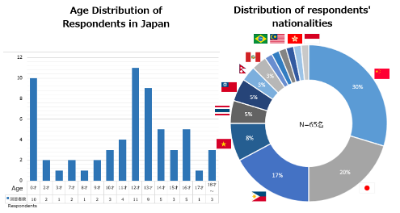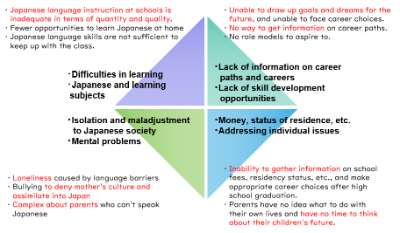Survey on High School Life of Young People with Immigrant Background
glolab conducted a questionnaire survey on high school life for people aged 15-30 with immigrant background. We also conducted interviews with young people with immigrant background, people involved in NPOs and support groups, and high school teachers and staff to discuss the issues and factors involved.
1. Awareness of the Issues
As of June 2020, the number of foreign nationals residing in Japan for the medium to long term will exceed 2.88 million. As the number of foreign nationals increases, the number of children who come to Japan under the age of 18 is also increasing due to their parents’ work commitments.
According to the Ministry of Education, Culture, Sports, Science and Technology’s “Surveyon the Actual Conditions of High School Students Who Need Japanese Language Instruction and Have Dropped Out of School,” there are more than 4,000 high school students in Japan who need Japanese language instruction, and the number has increased 2.7 times in the past 10 years.
The dropout rate was 9.6% (1.3% of all high school students), the rate of higher education was 42.2% (71.1% of all high school students), the rate of non-regular employment was 40% (4.3% of all high school students), and the undecided rate of neither employment nor higher education was 18.2% (6.7% of all high school students). The undecided rate was 18.2% (undecided rate for all high school students: 6.7%).
It can be seen that it is not easy for young people with immigrant background to live in Japanese society. Therefore, we conducted a survey to identify the challenges that high school students with immigrant background face in their high school life, and to consider the factors and proposed countermeasures.
2. Survey Summary
(1) Objective
Identifying the challenges that high school students with immigrant background face in high school life
(2) Methods
Qualitative evaluation: In-depth-interview and Focus Group Interview
Evaluation by quantitative survey: Questionnaire survey by Pre-Recrui
(3) Target group
< person concerned> High school and university students and adults with immigrant background:
Qualitative research collaborators: 5, Quantitative research collaborators: 65
< person(s) concerned> NPO personnel, volunteers, etc.:
Qualitative research collaborators: 5, Quantitative research collaborators: 7
< person(s) concerned> High school teachers and staff:
Quantitative research collaborators: 21 people

3. Survey Results (Summary)
The three years of high school are an important time for students to study and think about their future career paths. High school students with immigrant background face various challenges such as “language barrier,” “place to stay,” “career path,” and “money and status of residence.
However, in high school settings, there are cases where it is difficult to discover the challenges of students with immigrant background and to provide individualized support regarding money and residency status. Also, support from home may not be sufficient in some cases.
Therefore, it is important to accompany students and provide individualized support based on a safe place to work inside and outside of school, and for NPOs and schools to share information about students and knowledge and networks regarding support, and to collaborate.
■Four challenges faced by high school students with immigrant background
High school students with immigrant background face four major challenges.
The first point is insufficient Japanese language acquisition. As background, there are few opportunities to receive Japanese language instruction at high schools and few opportunities to be exposed to Japanese at home. As a result, they are unable to keep up with their classes.
Secondly, there are mental issues such as loneliness due to not being able to speak Japanese and denial of one’s mother culture and identity due to bullying. Some of the students said that they thought about dropping out of school because they could not find a place to stay.
The third point is the lack of opportunities to develop information and skills about career destinations and careers. Schools do not have much time to provide individualized career education and support, and may only provide information on universities, colleges, etc. In addition, if there is a lack of communication with parents or if parents are living in hardship as workers, it is difficult for them to hold an image of future work. Furthermore, parents may be indifferent to or have no time to think about their children’s education and future.
The fourth point is to deal with tuition, scholarships, and residence status. In areas where specialization and complex procedures are required, support from lawyers and others is necessary, but there are cases where there is not sufficient coordination.

We will analyze it in more detail below.
■Half of the students who came to Japan after the age of 13 experienced challenges in learning Japanese, learning subjects, and adjusting to school culture.
In the questionnaire, about 50% of the students who came to Japan at the age of 13 or older answered that “language acquisition, subject learning, and adaptation to school culture” were their challenges. In fact, the following comments were made in the interviews.
”I don’t understand my classes well enough. I can’t study.”
”I can’t make friends.”
”I don’t understand the unique Japanese school culture and hierarchy.”
One of the interview respondents studied for the entrance exam in a short period of time and entered high school, but lost her place due to the lack of good relationships in the classroom and club activities, and “thought about dropping out of high school amidst feelings of helplessness and loneliness. On the other hand, there was a person who had difficulty learning Japanese when he first came to Japan, but was able to use the English and mathematics he learned in his home country to advance to university.
■Lack of opportunities to develop information and skills to develop a future vision and career path
High school students with immigrant background are working hard to learn Japanese and study their subjects while seeking a career path toward their future goals. However, the process is not an easy one.
About 20% of the survey respondents indicated that they were facing challenges in their search for a future vision, as shown below.
”I don’t know what I like to do or what I’m good at.”
”I don’t know what I want to study.”
”I don’t know what I want to do after I graduate from high school.”
About 40% of the respondents said that they had the intention to go on to higher education or find a job, but did not have enough access to information about universities and companies and wanted more information.
In fact, the following comments were made during the interviews, showing that some students are unable to envision their future and are unable to fully consider their career paths, and make their career choices based on information from a limited number of people, or in some cases, give up on further education or employment and return home.
”I decided where to go after receiving information from a volunteer at a support group.”
”I decided on a job through a recommendation from a friend of my parents.”
”I couldn’t find anyone around me to talk to about my future plans, so I gave up on further education or employment and returned home.”
On the other hand, nearly 30% of the respondents answered that they need “interaction with university and vocational school students with immigrant background,” “experiences of role models,” and “internships and work experience. It is thought that by coming into contact with real information from friends and seniors who are close to them in their circumstances, and by learning from their own experiences, they will have more options and be able to make more satisfactory career choices.
■Individualized support is needed for each student’s situation, such as “status of residence” and “school fees and money.
We need to provide individualized support for each student’s situation in terms of residence status, school fees, and money.
However, high school teachers and staff pointed out that “we don’t have a good grasp of what kind of issues they are facing” and “we don’t provide enough information about entrance exams, job opportunities, and stories from seniors. ” In addition, some teachers said that they would like to take advantage of the university entrance examination system that allows them to make use of their immigrant background, or to provide career guidance in fields where they can utilize the strengths of their immigrant background, but there are differences in knowledge and experience among teachers.
High school teachers and staff may have a large number of students with various backgrounds, and may have limited time to interact with students with immigrant background and provide career guidance. In addition, there are language limitations when communicating with parents. In addition, residency status, etc. requires specialized knowledge or collaboration with those who have specialized knowledge.
On the other hand, there is not enough support from home. About 10% of the survey respondents said that they had never consulted their parents about their career paths and careers, citing “my parents were very busy (running a restaurant, working in a factory, etc.)” and “they were not very interested in my education. When I talked to my parents about going to school, they were not very interested. In the end, I had to find the money to go to school on my own. This suggests that there are many cases where there is not enough support from home.
4. For the future
As mentioned above, there are a wide range of challenges faced by high school students with immigrant background. In order to solve these issues, it is necessary to stay close to the students based on a safe and comfortable place to work both inside and outside of school. In this context, we believe that the following activities will be important.
■To make students aware of potential problems, and accompany them to solve them on their own with a sense of ownership.
■Teachers and staff will be more proactive in asking questions and reaching out to high school students with immigrant background to understand their potential issues.
■We will collaborate with NPOs, lawyers and other experts to share potential issues, support know-how and information with the students.
By providing a comprehensive support system for high school students with immigrant background, glolab hopes to create a society in which as many young people as possible with immigrant background can take ownership of their lives and make career choices with a sense of acceptance.
5. Limitations of this survey
・The number of respondents (population) for the questionnaire survey to the parties was 65. Therefore, it was not enough to explain the statistical significance of any of the items. However, we were able to test the issues and hypotheses revealed in the questionnaire survey in the interview survey and deepen our discussion. In the future, we would like to collaborate with local governments, schools, and support groups so that we can conduct surveys with a larger sample.
・The target of this survey was high school and college students with immigrant background. Since there is no data for high school students, university students, and adults with “no immigrant background,” it was not possible to make comparisons. In addition, qualitative data from interviews with high school teachers and staff was insufficient to supplement this data. In the future, we would like to deepen our discussion through surveys of high school teachers and staff.
6. At the end
We would like to express our sincere gratitude to the following people who took time out of their busy schedules to fill out the survey: young people with immigrant background, teachers and staff at metropolitan high schools, the NPO Multicultural Education Network Kanagawa, the NPO Multicultural Center Tokyo, the NPO Minna no Ouchi, and other supporters (in no particular order).
Investigation: Kageyama, Shibayama, Hitomi, Sima
Report: Kageyama, Shirato

